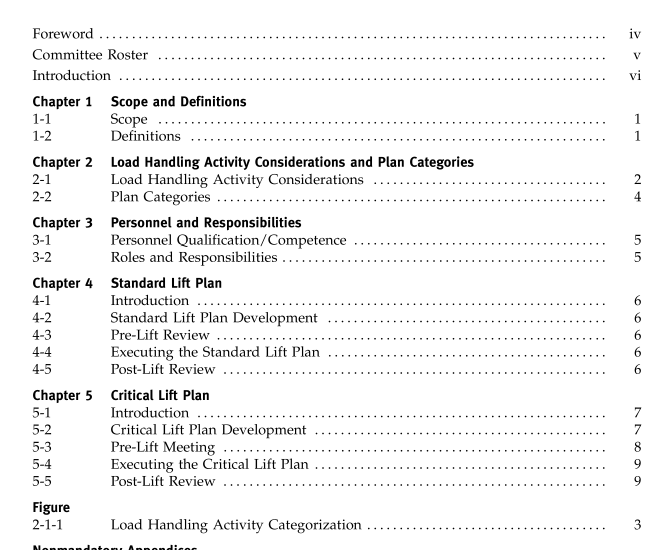ASME P30.1:2014 pdf download Planning for Load Handling Activities
5-1 INTRODUCTION
The decision to use a critical lift plan should be basedon the considerations outlined in Chapter 2.
The critical lift plan shall be written prior to executingthe load handling activity. See NonmandatoryAppendix A for an example lift plan template.
5-2CRITICAL LIFT PLAN DEVELOPMENT
The critical lift plan should address the applicableitems identified in paras.5-2.1 through 5-2.10 and anyadditional considerations identified during the planningprocess.
5-2.1 The Load
(a) Identify the load’s weight, center of gravity, anddimensions, and the sources of that information.
(b) Identify components that could shift during theload handling activity and develop a method for secur-ing, if required.
(c) ldentify the load attachment or contact points andensure that they are suitable for the load to be handled,while maintaining load integrity.
(d) ldentify the requirements to be met for the load’sorientation and securement prior to the release of theLHE and rigging.
5-2.2 Load Handling Equipment
(a) Identify the LHE and the anticipated configura-tion(s).
(b Ensure that the LHE is capable of handling thetotal anticipated load, including the rigging, accessories,and attachments in the intended configuration(s).givingconsideration to the factors listed in (e).
(c) Ensure that the LHE is in compliance with therequirements of the site, the manufacturer or qualifiedperson, industry-recognized standards (e.g., applicableASME B30 volume), and federal,state,or localregulations.
(d) Establish the process to set up, erect, or install, anddismantle the LHE using the information provided by
(1) the manufacturer
(2) a qualified person
(3) site-specific recommendations
(4) applicable regulatory requirements
(e) Identify all required inspections and tests on theLHE that need to be performed using the information
provided by the manufacturer, a qualified person, site-specific recommendations, or applicable regulatoryrequirements. For repetitive lifts, additional LHE inspec-tion and maintenance should be considered.
5-2.3 Rigging
(a) Establish the rigging method that will support andsecure the load and is suitable for the load handlingactivity.
b) Ensure that the rigging method and the equipmenthave the capacity to support the load, in the configura-tion or geometry required, giving consideration to thefactors addressed in para.5-2.1 and the following:
(1) dynamic effects (beyond that considered in thedesign of the equipment)
(2) adverse environmental conditions (tempera-ture, wind, water / ice)
(3) position of the center of gravity relative to rig-ging support points
(4) D/d ratio
(c)Identify the weight of the rigging, accessories, andattachments, and the sources of that information.
(d) Establish the process to ensure that the riggingequipment meets the manufacturer’s specifications, reg-ulations,industry-recognized standards (e.g-,ASME B30.9,B30.20,B30.26), and site-specific require-ments for the methods and equipment selected.
(e) Identify all necessary inspections and tests for therigging equipment.
(f ) For repetitive lifts, establish any additional rigginginspection and maintenance requirements that may benecessary.
(g)Establish the process to install and disassemble therigging equipment using the information provided by
(1) the manufacturer
(2) a qualified person
(3) site-specific recommendations(4) applicable regulatory requirements
(h) Ensure that the rigging will be protected fromdamage during the load handling activity from condi-tions such as the following:
(1) temperature (e.g., shielding from heat,cold)(2) degradation (e.g., chemicallyactiveenvironment)
(3) cutting, abrasion, and friction damage (e.g-.turning, shifting, contact with edges)
